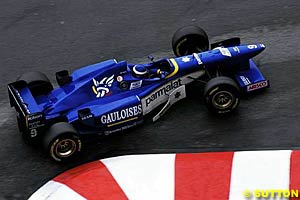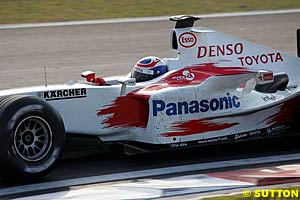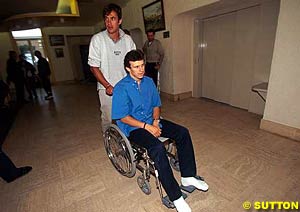
Atlas F1 Senior Writer
After 10 years in the sport, Olivier Panis has announced that he will retire as a Formula One driver following this weekend's Japanese Grand Prix, but will be retained by Toyota for two more seasons as a reserve driver. Thomas O'Keefe says goodbye to the popular Frenchman who has known the highs and lows of Grand Prix racing
Although in retrospect it may seem like a dream even to the man himself, all this actually happened to 29 year-old Olivier Panis at Monaco in 1996, in an extraordinary race that rainy day in Monte Carlo when Panis won his only Grand Prix in the deep blue and white Gaulloises-sponsored French/Japanese confection called the Ligier JS43, powered by a 3.0 litre V10 Mugen-Honda engine. Another singularity to this victory is that the once-powerful privateer Ligier team, named after French rugby player and driver Guy Ligier and regarded as the French National Team of the time, had not won a race in 15 years and would never win a race again. For that matter, Honda had not won a Grand Prix since leaving the sport in 1992, so the faux-Honda victory was also a novelty.
Behind Olivier Panis' Ligier lay wreckage of tremendous magnitude in the streets of the Principality, even by the standards of Formula One. Two Ferrari F310's had crashed into the Armco barriers at Portier, Michael Schumacher on lap 1 and Eddie Irvine on lap 68 with only a few laps to go; two 1995 World Championship Kingfisher-sponsored Benetton B-196's were also parked, Jean Alesi's having developed right rear suspension problems after leading the race for 19 laps.
The two Mikas ran into one another as a result of a chain reaction accident at Portier after Irvine's Ferrari spun just in front of them while the Finns were running nose-to-tail. One supposed-Iceman (Salo in the Tyrrell-Yamaha) gestured angrily at future Ferrari teammate Irvine and the other Iceman (Hakkinen in the McLaren-Mercedes) leaped out of his Marlboro-red McLaren and pushed aside an innocent marshal in the Finnish Style (Kimi Raikkonen-like) who was simply trying to move Irvine's Ferrari out of harms way.
Did I mention that this 1996 Monaco Grand Prix had everything and everyone in it (at least it did at the beginning!), making it all the more noteworthy that Olivier Panis emerged as The Survivor amongst such an illustrious field?
Monaco-resident David Coulthard in the other McLaren-Mercedes ran out of helmets somehow in his hometown when he could not rid himself of his visor misting over and Michael Schumacher loaned Coulthard a spare, resplendent with seven iridescent stars on top, just like Schumi's: a friend in need is a friend indeed. It brought DC some Schumacher luck as Coulthard finished second to Panis in his McLaren MP4-11, and was closing within 1.1 seconds towards the end under the influence of the lucky Schumacher helmet.
As usual, Flavio Briatore, then team manager at Benetton and presiding over the disappointing duo of Alesi and Gerhard Berger, was in the thick of it, as Alesi led much of the race though Berger packed it in early with gearbox troubles. It should be remembered that as of 1996, Briatore was also team owner of the Ligier team that was about to win the Monaco Grand Prix; in fact, the Benetton and the Ligier chassis looked remarkably alike. As the Benetton mechanics packed up after Alesi's retirement on lap 60 of the 75-lap race, Flavio seamlessly sauntered over to the Ligier pit wall and began to share in the reflected glory of the last 15 laps. Some things don't change; somehow, Flavio always ends up on his feet.
Out of this chaos, only four cars were running at the end of the race: Panis, Coulthard, and the Sauber teammates, Johnny Herbert and Heinz-Harald Frentzen, with Panis taking the big prize. During the race, Panis charged up through the field, nudging Irvine's Ferrari off at the Loew's Hairpin and keeping his cool on a difficult day when many more experienced drivers lost theirs.
As spectacular as that day in Monaco was, however, it sometimes seems that Olivier Panis used up his good fortune in Grand Prix racing all at once, spreading out nothing but bad luck and unfulfilled promise over the rest of his career. But don't tell that to the ever positive-minded Panis. Now 38 years old and the oldest on the grid, sharing the senior ranks with 35 year-old Michael Schumacher, the remarkable Panis is as enthusiastic as ever about Formula One and will tackle his role in 2005 as third driver for Toyota with the same determination that he has demonstrated in 156 races over 10 seasons as a driver.
In addition to chassis development, Panis also has a phenomenal memory about his experiences in the car which is also invaluable to those back in the garage and those back in the factory working on the test bench. Unlike most drivers (but like Michael Schumacher at Ferrari), he also makes it a point to go to the Toyota factory in Cologne, and talk to the department heads running the Toyota Formula One operation. Indeed, Panis almost single-handedly invented the concept of "third driver," which is now a position on all of the major teams, in addition to the test drivers that do the grunt work like tire testing for the teams.
Panis also brings the experience of helping develop the Other Japanese engine, based upon his two years at BAR Honda as teammate to Jacques Villeneuve. Having just spent a year with a top team like McLaren, Craig Pollock, BAR's team principal at the time, hired Panis to complement Villeneuve. Said Pollock: "Olivier is extremely good at analyzing chassis performance, but he is just as good at analyzing engine performance. That's rarer."
Although BAR Honda would be leading races by 2003 at Indianapolis and Suzuka and fighting for a win by the 2004 season, Panis would have to be content to have served during BAR Honda's teething years – 2001 and 2002 – when a podium was something only Villeneuve could achieve (and then only twice). Nevertheless, Panis was reconciled to his plight while at BAR Honda, which was to help develop the BAR Honda while still managing a few good finishes in the points, a fourth place in the 2001 Brazilian Grand Prix, two fifth place showings (Austria 2001 and Silverstone 2002) and one sixth place at Monza in 2002, for a total of eight points scored for BAR Honda.
Difficult as these two years were for Olivier Panis, ranking 14th in the Drivers' Championship, his top finish of fourth place at Brazil in 2001 for BAR Honda is in fact higher than his best fifth place finish for Toyota to date (twice, at the 2003 German Grand Prix and the 2004 US Grand Prix) and indeed fourth place is the highest position Panis has reached since his horrific accident in the Prost JS45 in the 1997 Canadian Grand Prix. Understandably, the crash at Montreal seemed to retard his career, although the accident is thought to have been caused by failure of a mechanical component that had been weakened in a prior incident rather than driver error.
So Panis has been through much in his 10 years in Formula One, struggling with the homegrown French Ligier and Prost teams in the early years of his career but topping off that phase of his career with the win at Monaco. In the later stages of his career, Panis has been consigned to becoming a third driver at McLaren for a year when he would rather have been racing and serving as development driver for two well-funded but new teams, BAR Honda and Toyota, hoping against hope most recently that he could remain as a principal driver long enough for the hard development work to pay off with podiums and wins for Toyota.
But like his former teammate Jacques Villeneuve, who was let go by BAR Honda at the end of 2003 just when the team was about to show some promise in 2004, it now appears that Olivier Panis has had his last visit to the podium back in Barcelona when he finished second to Villeneuve's Williams at the 1997 Spanish Grand Prix in his Prost JS45-Mugen Honda, almost a year to the day from Panis' Monaco victory; in all likelihood, Panis will not be there to be the beneficiary when Toyota comes good, as it inevitably will. And, sad to say, Panis now seems likely to become a permanent member of that elite group of 31 drivers who have won only one World Championship Grand Prix. But what a victory it was, the kind of a day that will last a lifetime.
So is this the end of the Formula One racing career of Olivier Panis? Not necessarily, though he will be 40 years old at the end of his two-year tenure at Toyota as its third driver in 2006. These days it is becoming increasingly the case that test drivers like Zonta, Anthony Davidson, Antonio Pizzonia, Marc Gene, and Takuma Sato get their opportunity to race and not just test, and the Toyota press release on Panis' "retirement" left just a smidgeon of hope that sometime in the next two seasons he may get a final crack at contesting a Grand Prix even though he will be pushing 40, just about the age Juan Manuel Fangio was when he won his first Grand Prix in 1950. Says Toyota in its September 9, 2004 press release: "With over 150 GP's of experience as a race driver, [Olivier Panis] will also act as our reserve driver in case either of our race drivers cannot participate in a GP weekend." Ironically, Jarno Trulli, who now replaces Panis at Toyota, is the driver who got his first big break filling in at Prost for the injured Olivier Panis after Panis' accident in Canada in 1997.
We wish no one ill. But if either Trulli or Ralf Schumacher are sidelined in 2005 and 2006 and Panis gets one last shot at winning a Grand Prix at a time when the Toyota is competitive, Max Mosley himself would not begrudge Panis notwithstanding FIA Sporting Regulation 172 ("after receiving the end-of-race signal all cars must proceed . . . to parc ferme without stopping, . . . without receiving any object whatsoever"), if by chance some Frenchman unfurled a Tricolor for Panis to wave one last time during his victory lap. Let's hope this good and graceful man has the chance.
If you happen to be a French Formula One driver and you had to wish to win only one race in your career, it would unquestionably be the Monaco Grand Prix. To make this dreamy achievement even better, why not have it be raining on the slippery streets of Monte Carlo and why not try running a risky one-stop fuel strategy, gambling as you circulate by the Casino that the race would come to you.
 And when the race does go your way and you see the checkered flag, pinch yourself when you cross the line in front of the Royal Box and catch a wave from the gloved hand of Princess Stephanie under her parapluie. Then pluck from a countryman a huge French Tricolor to wave from the cockpit in your cool-down lap, the flag rippling in the breeze. And through your helmet and earplugs and over the noise of the engine, hear the yacht sirens and fireworks from the harbor and see through your oil-smeared visor fans all around the circuit leaning over the Armco barriers to reach out and touch the Frenchman who won the Grandest Grand Prix of all.
And when the race does go your way and you see the checkered flag, pinch yourself when you cross the line in front of the Royal Box and catch a wave from the gloved hand of Princess Stephanie under her parapluie. Then pluck from a countryman a huge French Tricolor to wave from the cockpit in your cool-down lap, the flag rippling in the breeze. And through your helmet and earplugs and over the noise of the engine, hear the yacht sirens and fireworks from the harbor and see through your oil-smeared visor fans all around the circuit leaning over the Armco barriers to reach out and touch the Frenchman who won the Grandest Grand Prix of all.
 The two Rothmans Williams FW18 drivers – Damon Hill and Jacques Villeneuve – had both retired, Hill while well in the lead when his Renault engine blew up exiting the tunnel and Villeneuve when he got squeezed into the wall at Mirabeau by Luca Badoer, currently Ferrari's principal test driver, but then piloting the lowly Forti-Ford. Badoer was later found to be guilty of careless driving and was suspended for it.
The two Rothmans Williams FW18 drivers – Damon Hill and Jacques Villeneuve – had both retired, Hill while well in the lead when his Renault engine blew up exiting the tunnel and Villeneuve when he got squeezed into the wall at Mirabeau by Luca Badoer, currently Ferrari's principal test driver, but then piloting the lowly Forti-Ford. Badoer was later found to be guilty of careless driving and was suspended for it.
 Panis is perfect for the role of continuing to develop the new Mike Gascoyne-designed Toyota TF104B chassis in the works at Toyota's factory in Cologne, Germany, having served for one whole season as a test driver for Adrian Newey's McLaren-Mercedes in 2000, a year when Panis proved his quickness in private testing against the likes of two-time World Drivers' Champion Mika Hakkinen and also showed that he could provide the technical feedback to the McLaren engineers that improved the car for the whole team.
Panis is perfect for the role of continuing to develop the new Mike Gascoyne-designed Toyota TF104B chassis in the works at Toyota's factory in Cologne, Germany, having served for one whole season as a test driver for Adrian Newey's McLaren-Mercedes in 2000, a year when Panis proved his quickness in private testing against the likes of two-time World Drivers' Champion Mika Hakkinen and also showed that he could provide the technical feedback to the McLaren engineers that improved the car for the whole team.
 How bad was Panis' accident at Montreal? When Dr. Sid Watkins and his medical team arrived on the scene what Dr. Watkins saw was that Olivier's "right leg was fractured below the knee . . . so I set about splinting Olivier's leg above and below the obvious fracture . . . Panis . . . then indicated that his left leg was also painful . . . The quickest way to deal with this was to splint the left leg to the already splinted right." By the time the doctors had stabilized Panis' two broken legs, Dr. Watkins realized that there was silence at the accident scene: the race had been stopped. And indeed it had been, with 15 laps to go, a controversial decision. Nevertheless, 15 weeks after Panis hit the wall with his Prost at Montreal, he was back in the car.
How bad was Panis' accident at Montreal? When Dr. Sid Watkins and his medical team arrived on the scene what Dr. Watkins saw was that Olivier's "right leg was fractured below the knee . . . so I set about splinting Olivier's leg above and below the obvious fracture . . . Panis . . . then indicated that his left leg was also painful . . . The quickest way to deal with this was to splint the left leg to the already splinted right." By the time the doctors had stabilized Panis' two broken legs, Dr. Watkins realized that there was silence at the accident scene: the race had been stopped. And indeed it had been, with 15 laps to go, a controversial decision. Nevertheless, 15 weeks after Panis hit the wall with his Prost at Montreal, he was back in the car.
|
Contact the Author Contact the Editor |
Please Contact Us for permission to republish this or any other material from Atlas F1.
|
Volume 10, Issue 40
Articles
Interview with Giancarlo Fisichella
Sayonara Oli
2004 Japanese GP Preview
2004 Japanese GP Preview
Japanese GP Facts & Stats
Columns
The F1 Trivia Quiz
Bookworm Critique
On the Road
Elsewhere in Racing
The Weekly Grapevine
> Homepage |